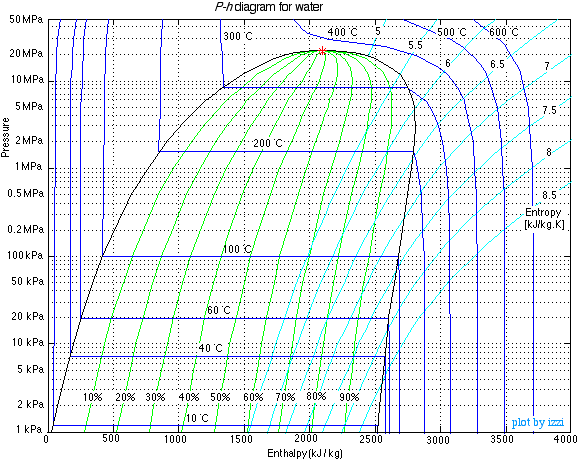
We introduced the basic Steam Power Plant in Chapter 4b, however we could only evaluate the turbine and feedwater pump after we introduced the concept of entropy in Chapter 6a. In this Chapter we will consider ideal steam power cycles including isentropic turbines and pumps. This will allow us to determine the maximum performance of these systems, and evaluate the influence of various components on this performance.
The pressure-enthalpy (P-h) diagram
The common method of describing steam power plant systems is by plotting them on a T-s (temperature-entropy) diagram for steam. This is done exclusively in all thermodynamic text books that I have evaluated over many years. We find this approach cumbersome, non-intuitive and even incorrect in the description of feedwater pumps. We will make exclusive use of P-h (pressure-enthalpy) diagrams (which we inroduced in Chapter 4b) to describe the various steam power systems and we will require that all problems to be solved should first be drawn on the P-h diagram.
A typical P-h diagram for steam is shown below. One aspect of the diagram that we have ignored until now are the various constant entropy lines drawn in the superheated and high quality section of the diagram. We will use these lines to indicate the path of an isentropic turbine for the ideal cycles described below. We do not require this for the feedwater pumps since, as we determined in Chapter 6a, the isentropic pump follows the constant temperature line.
This is shown below as an Ideal Rankine cycle, which is the simplest of the steam power cycles. We have specifically split the turbine into a High Pressure (HP) turbine and a Low Pressure (LP) turbine since it is impractical for a single turbine to expand from 15MPa to 10kPa.
As stated above, our approach is that prior to doing any analysis we will always first sketch the complete cycle on a P-h diagram based exclusively on the pressure and temperature data presented, as follows:
Notice that since both turbines are considered ideal, they follow the isentropic curve (1)-(2). From the P-h diagram we see that the LP turbine output (station (2)) has a quality of 80%. This is unacceptable. The condensed water will cause erosion of the turbine blades, and we should always try to maintain a quality of above 90%. One example of the effects of this erosion can be seen on the blade tips of the final stage of the Gavin LP turbine. During 2000, all four LP turbines needed to be replaced because of the reduced performance resulting from this erosion.
Thus once we have determined from the P-h diagram that this cycle is impractical we have no reason to continue with the analysis, and prefer to extend this into an Ideal Reheat steam power cycle as follows.
A High Pressure Ideal Reheat Steam Power Cycle
We extend the above example to the more practical Ideal Reheat cycle as shown below. In this example the HP turbine expands the steam from 15 MPa to 1 MPa, and the steam is subsequently reheated back to 600°C before being expanded in the LP turbine to 10 kPa.
Again we plot this cycle on the P-h diagram and compare it to the previous situation of no reheat, as shown below:
We notice that reheating the output of the HP turbine back to 600°C (process (2)-(3)) allows both significantly more power output as well as increasing the quality at the LP turbine output (4) to 98%.
The method of analysis is similar to that developed in Chapter 4b, in which we consider each component as a separate control volume.
1) Assuming both turbines are isentropic (adiabatic and reversible), and neglecting kinetic energy effects we use the steam tables to determine the combined work output of both turbines.
2) In this ideal cycle we assume that the feedwater pump is isentropic. Furthermore, since the suction temperature of the water is 46°C, we assume that it behaves as an incompressible liquid, even at 15 MPa. Recall the section from Chapter 4b where we derived the energy equation for an incompressible liquid.
3) The total heat transfer to the boiler, including the reheat system:
4) The thermal efficiency of the ideal Rankine reheat system, defined as the net work done (turbines, pump) divided by the total heat supplied to the boiler:
Notice that we could have also determined the thermal efficiency by the simpler method of evaluating the condenser heat transferred to the cooling water, thus:
This is an excellent check and should always be done to validate your answer. The reason why we have preferred to evaluate the output power directly is that it is the primary purpose of a steam power plant, thus we are always interested in the various components (turbines, pumps) that directly influence its value. Thermal efficiency is important in its own right, however only on condition that we can satisfy the output power requirements of the steam power plant.
______________________________________________________________________________________
![]()
Engineering Thermodynamics by Israel
Urieli is licensed under a Creative
Commons Attribution-Noncommercial-Share Alike 3.0 United States
License